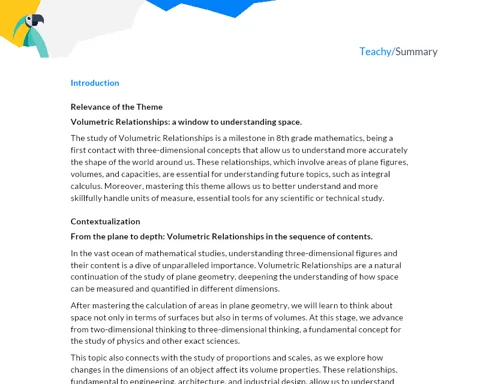INTRODUCTION
The Relevance of the Topic
Exploring the World of Decimal Numbers! 🧭💡 Decimal numbers are like pieces of a big math puzzle. They help us count tiny things, like breadcrumbs, droplets of water, or coins in a piggy bank. When we talk about tenths and hundredths, we are entering a world where everything is divided into even smaller parts, and knowing this is like having a magic magnifying glass to see every little piece of daily life!
Contextualization
The Journey of Numbers: From the Land of Naturals to the Valley of Decimals! 🌳🌄 So far, we have explored the land of natural numbers - whole numbers we use to count complete things. But what if we want to count parts of something? That's where the heroes of this lesson come in: decimal numbers! Like pieces that fit perfectly, tenths and hundredths are the first steps in this new territory, full of fractions and divisions. They are essential to understand everything that follows on our math map, from buying a sweet at the cafeteria to measuring how many liters of juice fit in a pitcher. Let's embark on this adventure and discover how these tiny numbers transform the world around us!
Magic Reminder: "Small Parts Make Big Sums!" 🧩✨
THEORETICAL DEVELOPMENT
Components
-
Tenths:
- Each tenth is 1 part of 10 equal parts of a whole.
- Imagine a pizza cut into 10 equal slices; each slice is a tenth!
- In the world of decimal numbers, we use the dot (.) to separate tenths from whole numbers.
- The tenth comes right after the dot: 0.1, 0.2, up to 0.9.
-
Hundredths:
- Each hundredth is 1 part of 100 equal parts of a whole.
- Think of a chocolate bar divided into 100 little squares; each square is a hundredth!
- They are two places after the dot: 0.01, 0.02, up to 0.99.
-
Decimal Place:
- Each position after the dot has a name.
- The first position is for tenths and the second for hundredths.
- The order is important, just like in numbers before the dot.
Key Terms
-
Decimal Number:
- It is a number that has an integer part and a fractional part separated by a dot.
- Example: 2.34 has 2 as the integer part and 34 as the fractional part.
-
Integer Part:
- It is the number to the left of the decimal point.
- Shows how many complete units we have.
-
Fractional Part:
- It is the number to the right of the decimal point.
- Shows the fractional parts of a unit.
-
Decimal Point:
- It is the separator between the integer and fractional parts.
- In Brazil, we use the dot, but in some countries, the comma is used.
Examples and Cases
-
Using Tenths:
- If we have 0.3 liters of juice, it means we have 3 tenths of a liter, in other words, 3 parts of 10 of a whole liter.
-
Using Hundredths:
- If a ruler is 0.25 meters, we are talking about 25 hundredths of a meter, that is, 25 parts of 100 of a whole meter.
-
In the Monetary System:
- R$1.25 means 1 real and 25 cents.
- The cents are like hundredths of a real.
- So we have 1 whole part (the real) and 25 fractional parts (the cents).
Catch Phrase: "Every number is a hero in its decimal place: tenths and hundredths, the small great adventurers of the numeric world!" 🏰🏹
DETAILED SUMMARY
Key Points
-
Understanding the Decimal System:
- We learned that the decimal system separates numbers into integer and fractional parts through the dot.
- This separation is crucial to understand how to represent values smaller than one.
-
Mastering Tenths and Hundredths:
- We saw that tenths are the first positions after the dot, and each represents one part of ten.
- Hundredths come right after tenths and are each of the parts we divide a unit into a hundred.
-
Practicality of Decimal Numbers:
- We realized how decimal numbers are used in daily life, especially in money and measurements.
- We learned how decimal numbers facilitate the exact expression of quantities that are not whole numbers.
-
The Decimal Place:
- We understood that the position of a number after the dot influences its value as a tenth or hundredth.
- We learned the correct reading of decimal positions, which is essential for the proper use of numbers.
-
Connection with Money:
- We related the concepts of tenths and hundredths to reals and cents, which helps understand the monetary system.
- We reinforced the importance of decimal numbers in daily life, especially when dealing with money.
Conclusions
-
Important Representation:
- We concluded that decimal representation is essential for precision in various contexts, such as money, science, and everyday measurements.
-
Everyday Math:
- We identified that understanding tenths and hundredths is constantly applied in practical situations, making them accessible and useful concepts.
-
Foundation for Future Learning:
- We recognized tenths and hundredths as fundamental building blocks for the mathematical knowledge that will be built in the coming years, such as more complex fractions and percentages.
Exercises
-
Let's Count Cents:
- If you have R$2.45, how many cents do you have in total?
-
Measure and Compare:
- Complete: 0.7 m is equal to ___ cm. Tip: remember how many centimeters are in a meter!
-
Decimal Pizzeria:
- If a pizza was cut into 10 slices and you ate 2, what fraction of the pizza did you eat? And how would we write this in decimal form?
Final Catch Phrase: "Deciphering the code of tenths and hundredths, each number tells a story full of incredible details!" 📖🔍



